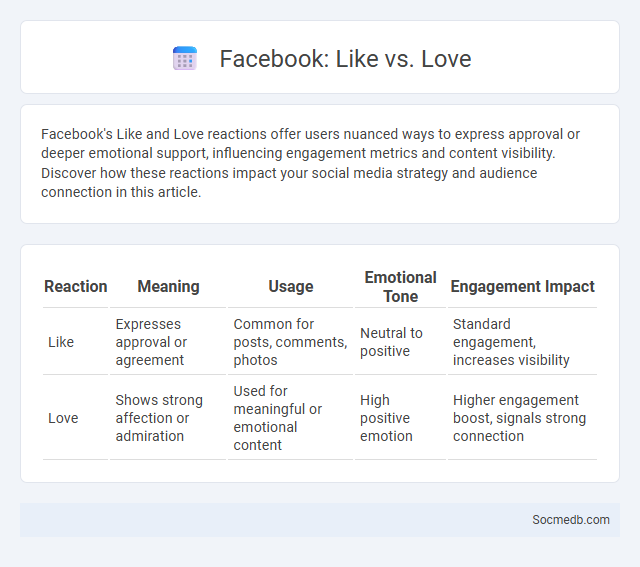
Photo illustration: Facebook Like vs Love
Facebook's Like and Love reactions offer users nuanced ways to express approval or deeper emotional support, influencing engagement metrics and content visibility. Discover how these reactions impact your social media strategy and audience connection in this article.
Table of Comparison
| Reaction | Meaning | Usage | Emotional Tone | Engagement Impact |
|---|---|---|---|---|
| Like | Expresses approval or agreement | Common for posts, comments, photos | Neutral to positive | Standard engagement, increases visibility |
| Love | Shows strong affection or admiration | Used for meaningful or emotional content | High positive emotion | Higher engagement boost, signals strong connection |
Understanding Facebook Reactions: Like vs Love
Facebook Reactions offer nuanced ways to express your feelings beyond a simple Like, with the Like symbolizing general approval and Love indicating stronger affection or support. The Love reaction often garners more engagement, signaling deeper emotional connection in posts, which can influence algorithmic prioritization in your newsfeed. Understanding these distinctions helps you communicate your emotions more effectively and enhances interaction quality on the platform.
The Origin and Evolution of Facebook Likes
Facebook Likes originated in 2009 as a pioneering feature allowing users to express approval with a simple click, revolutionizing online interaction by providing instant feedback on posts. Over time, this feature evolved to include reactions such as love, anger, and sadness, enhancing emotional expression and engagement metrics. The Like button became a core element in social media algorithms, directly influencing content visibility and user experience on the platform.
What Does the Facebook "Like" Mean?
The Facebook "Like" serves as a quick and simple form of engagement, signaling approval, interest, or agreement with a post, comment, or piece of content. It functions as an essential metric for user interaction, influencing content visibility through Facebook's algorithm by increasing the likelihood that liked posts appear in users' news feeds. This microinteraction also provides social proof, impacting both personal connections and brand credibility by showcasing popularity and support.
Decoding the "Love" Reaction on Facebook
The "Love" reaction on Facebook represents a deeper emotional engagement compared to a simple "Like," signaling strong positive sentiment towards shared content. This reaction often correlates with posts that evoke intimacy, appreciation, or personal connection, making it a valuable metric for gauging audience affection and brand loyalty. Analyzing the frequency and context of "Love" reactions can provide insights into user behavior and enhance content strategy effectiveness on social media platforms.
Emotional Impact: Like vs Love on Social Engagement
Social media interactions like "Like" and "Love" significantly influence emotional engagement and user behavior on platforms such as Facebook and Instagram. Your content receiving "Love" reactions tends to generate stronger emotional responses, leading to higher sharing rates and increased visibility compared to simple "Likes." Understanding this emotional impact helps optimize your social media strategy for deeper connection and enhanced audience loyalty.
User Intent: When to Use Like or Love
User intent in social media reactions drives the choice between "Like" and "Love," reflecting varying degrees of engagement and emotional connection. "Like" signals general approval or acknowledgment, commonly used for posts that are informative, casual, or neutral. "Love" conveys stronger emotions such as admiration, enthusiasm, or personal significance, often reserved for content that resonates deeply or celebrates milestones.
Algorithms and Engagement: Reactions That Matter
Social media algorithms prioritize user engagement by analyzing reactions such as likes, comments, shares, and time spent on content to determine relevance and visibility. These algorithms adapt dynamically, amplifying posts that generate meaningful interactions, which boosts organic reach and fosters community growth. Understanding how reactions influence algorithmic rankings helps creators and marketers optimize content strategies for better audience connection.
Sentiment Analysis: Insights from Facebook Reactions
Facebook reactions provide valuable data for sentiment analysis by capturing users' emotional responses beyond simple likes and dislikes. Analyzing these reactions reveals patterns in public opinion, helping Your brand understand audience sentiment towards content and products. Leveraging sentiment insights from Facebook reactions can enhance marketing strategies and improve customer engagement.
Business Perspective: Leveraging Likes and Loves
Businesses leverage likes and loves on social media as key indicators of audience engagement and brand sentiment, driving targeted marketing strategies. These reactions provide valuable data to optimize content, improve customer experience, and increase conversion rates. Effective use of social media analytics platforms enables companies to harness these insights for enhanced brand loyalty and revenue growth.
The Future of Facebook Reactions: Trends and Predictions
Facebook Reactions are evolving to include more diverse and personalized options, reflecting users' growing desire for nuanced emotional expression. Emerging trends indicate an increase in animated and customizable reactions powered by AI, enhancing real-time interaction and engagement on your posts. These innovations aim to deepen user connection and provide richer feedback, transforming how emotions are communicated on social media platforms.
 socmedb.com
socmedb.com